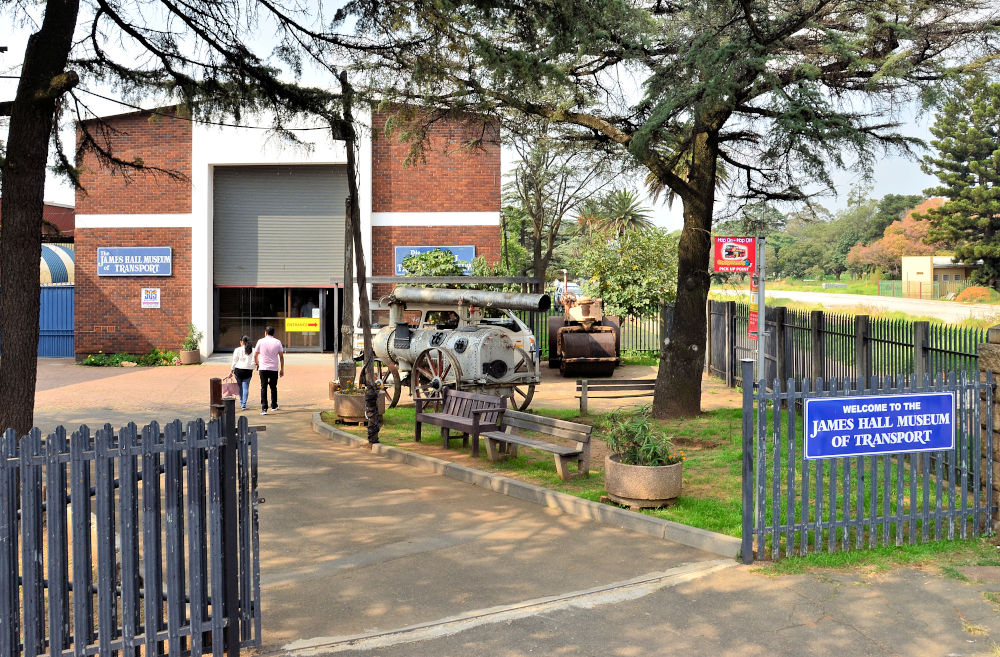It’s an odd, even an imperfect location to build a museum—to build, many may argue, any kind of structure at all. The location, Klipriviersberg 106-Ir, Johannesburg South, reads like it is made up to mislead. This is the James Hall Museum of Transport. It is in the middle of somewhere and nowhere, a ten-minute drive from the city, tucked at the bottom of the always busy, always perilous Rosettenville. The front of the museum faces the back exit of the Rand Stadium, where the professional football team Orlando Pirates trains, and next to it, separated by a fence, is Pioneer Park. Not far away is the Hector Norris Park, a cycling track, and beyond the park, leading up to the traffic light, a VW minibus restoration workshop.
Just by its location one can conclude that every single guest must come to the museum by way of a tourist city-exploration itinerary, planned over months. The museum: a tacked-on piece of sightseeing at the end of a long vacation. There must have been a time when the building looked better. Now, from the outside, it seems like it could do with some minor renovations. For some time now, a lone security guard watering a patch of grass is the only sign of any kind of visitor. The museum has been ‘temporarily closed’ for months. The security guard, when I drop by early one week and the week following that, only knows a few facts. He knows that he is there and that nobody else has been there for a long time. He knows that the museum is locked and that some of the employees don’t know when it will open. Some of the workers have shown up and found the doors locked, nobody is telling them why the museum is still closed, and when it will open again. He won’t say if the workers continue to be paid.
Now that the museum is closed, it is unclear where the entrance is, or where it used to be. It appears, by all observation, that one has to jump the steel fence to get in. The security guard’s office, right in front of Pioneer Park, is slowly being obscured by weeds. The plastic chair outside, facing the main road, is steadily being eaten away by sun and rain. The sign on the steel yard used to be blue.

Established in February 1964, by James ‘Jimmie’ Hall and the City of Johannesburg, the museum is alleged to be the biggest and most complete museum of land transport in South Africa. It includes an impressive collection of animal-drawn vehicles, bicycles and motorcycles, buses and coaches, fire engines and equipment, motor cars, steam-driven vehicles, trams and trolley buses.
The museum’s artefacts’ origins stretch over centuries, across transportation inventions, engineering evolutions and political histories. When it opened—1964 was a year in which South Africa sat, in the clutches of apartheid, on the edge of humanity—it surely must have only received the attentions of apolitical transportation fanatics. That year, there were other histories unfolding in the country that were far more urgent.
On 5 February of that year, the South African government formally refused to agree to a visit from a group of ‘experts to examine the problem of apartheid’, selected by the United Nations Secretary-General, saying it would be ‘an interference in the internal affairs of the Republic’. On 23 February, a weekly air route between Johannesburg and New York began operating, despite its being opposed by the UN Special Committee on Apartheid. On 12 June, the Rivonia Trial concluded, with Nelson Mandela, together with Denis Goldberg, Ahmed Kathrada, Govan Mbeki, Raymond Mhlaba, Andrew Mlangeni, Elias Motsoaledi and Walter Sisulu, narrowly escaping the death penalty. On 6 November, trade union leaders Vuyisile Mini, Wilson Khayinga and Zinakile Mkaba were hanged, becoming the first members of uMkhonto weSizwe to be executed by the apartheid state. Events that have come to define the history of the country.
Hall, a car enthusiast, who had a particular deep love for vintage models, worked with the city council to set up the museum. As reiterated in many of its 392 Google reviews, there is an unfortunate absence of well-researched text to go along individual pieces in the exhibit. Aesthetically, it is all very well that the museum has managed to secure a penny-farthing for its collection, but that there is limited information about its history, its arrival in Johannesburg, its use, and therefore its politics, is more than disappointing.
Arranged by year of invention, the museum travels through the history of transportation from the oldest vehicles to modern ones. The first section is dedicated to animal-drawn vehicles, and features two- and four-seater cape carts. Strewn about the yard, a contrast to the modern city that occupies the background, modern architecture cropped from the bottom up, is a collection of rollers, wagons, a jib crane, a tractor and a bus.
In the East Hall of the museum, the evolution of bicycles and motorcycles is documented. The museum’s bicycle display includes the aforementioned penny-farthing, a tandem and tricycles. Though one can hardly point to evidence of it now, the history of cycling in the city of Johannesburg is old, and black. The lack of text and historical context in the museum robs the exhibition of any of this rich history.
Making an attempt at telling the story of cycling history in Johannesburg, one finds Dr Njogu Morgan, writing in the Guardian. Morgan, a postdoctoral fellow at Wits, documents this history in an article titled ‘How apartheid killed Johannesburg’s cycling culture’:
‘What happened to Johannesburg’s once vibrant commuter cycling culture? The dominance of the automobile marginalised the bicycle in many cities around the world through the 40s, 50s, 60s and 70s but that process was accelerated in South Africa by apartheid. When policies of spatial segregation forcibly moved black people to faraway townships at the periphery of the city, the distance between work and home increased dramatically and cycling collapsed as an everyday practice.
‘Twenty-five years after apartheid’s fall, those spatial and economic inequalities remain entrenched in the city and continue to shape how people get around.’
It’s possible to think of the museum as simply an archive of old transport machines, but every museum, in some way, chronicles human historical evolution.
After the bicycle exhibit, in the North Hall, various modes of Edwardian-era transport and early motor cars are on display, chronologically tracking the development of various models, displaying invention, and insignificant and significant leaps of engineering. Documented here too, with English buses, are the leaps in which a country can, in various ways, impose itself on another.
The James Hall Museum, like all museums around the world, hangs on a precarious edge, inviting questions such as who owns it, who visits it, who is it for? With all of those converging points of discussion and potential disgust and disagreement, the James Hall Museum of Transport is, for now, a record for posterity of the mobility of the immigrants and residents of Johannesburg, who all travelled to and through the city in their own various ways.
- Guest City Editor Lidudumalingani is a writer, filmmaker and photographer, and winner of the 2016 Caine Prize. Follow him on Instagram and Twitter.





